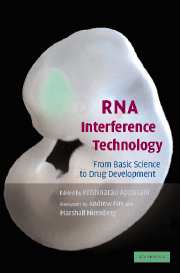Book contents
- Frontmatter
- Contents
- Foreword by Andrew Fire
- Foreword by Marshall Nirenberg
- List of Contributors
- Introduction
- Section one Basic RNAi, siRNA, microRNAs and gene-silencing mechanisms
- Section two Design, synthesis of siRNAs
- Section three Vector development and in vivo, in vitro and in ovo delivery methods
- Section four Gene silencing in model organisms
- 17 Practical applications of RNAi in C. elegans
- 18 Inducible RNAi as a forward genetic tool in Trypanosoma brucei
- 19 RNA-mediated gene silencing in fission yeast
- 20 RNA silencing in filamentous fungi: Mucor circinelloides as a model organism
- 21 RNAi and gene silencing phenomena mediated by viral suppressors in plants
- Section five Drug target validation
- Section six Therapeutic and drug development
- Section seven High-throughput genome-wide RNAi analysis
- Index
- Plate section
- References
17 - Practical applications of RNAi in C. elegans
Published online by Cambridge University Press: 31 July 2009
- Frontmatter
- Contents
- Foreword by Andrew Fire
- Foreword by Marshall Nirenberg
- List of Contributors
- Introduction
- Section one Basic RNAi, siRNA, microRNAs and gene-silencing mechanisms
- Section two Design, synthesis of siRNAs
- Section three Vector development and in vivo, in vitro and in ovo delivery methods
- Section four Gene silencing in model organisms
- 17 Practical applications of RNAi in C. elegans
- 18 Inducible RNAi as a forward genetic tool in Trypanosoma brucei
- 19 RNA-mediated gene silencing in fission yeast
- 20 RNA silencing in filamentous fungi: Mucor circinelloides as a model organism
- 21 RNAi and gene silencing phenomena mediated by viral suppressors in plants
- Section five Drug target validation
- Section six Therapeutic and drug development
- Section seven High-throughput genome-wide RNAi analysis
- Index
- Plate section
- References
Summary
The discovery of RNAi in C. elegans
This chapter presents an overview of the methods and practical applications of RNA interference (RNAi) in C. elegans. Major exploitation of RNAi in C. elegans dates from the observation by Fire et al. (1998) that the injection of sequence-specific double-stranded (ds)RNA into the germ line of C. elegans was capable of silencing the activity of its cognate gene. The resulting mutant phenocopy closely resembled the phenotype produced by a genetically null or reduced-function mutant. Amazingly, the effect was found to be cell non-autonomous – RNAi is capable of spreading across cell boundaries and affecting tissues beyond the germ line in C. elegans (Fire et al., 1998). This phenomenon is related to post-transcriptional gene silencing (PTGS) in plants and quelling in fungi, all of which are believed to be natural defence mechanisms against viral invasion or transposon jumping (Plasterk, 2002 and references therein). RNAi is now employed routinely across phyla as a tool for systematically analysing gene function in most organisms with complete genome sequences (Hammond et al., 2001). Gene silencing by RNAi holds great promise as a therapeutic for treating human disease and genetic disorders. Considerable progress has been made in understanding the molecular mechanisms underlying the process of RNAi and the reader is referred to other chapters in this book for details.
Information
- Type
- Chapter
- Information
- RNA Interference TechnologyFrom Basic Science to Drug Development, pp. 235 - 246Publisher: Cambridge University PressPrint publication year: 2005
